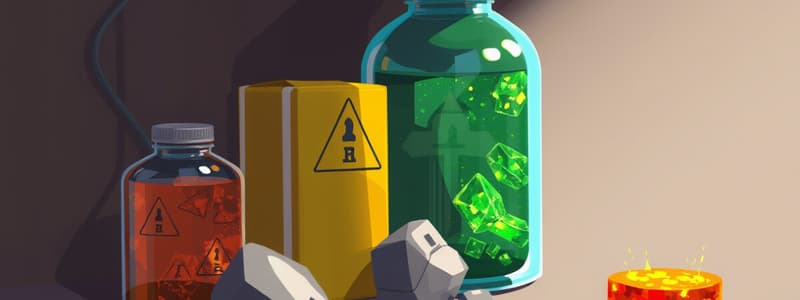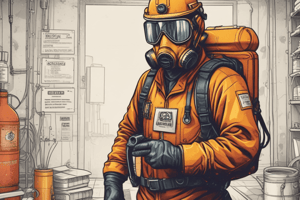Podcast
Questions and Answers
What does Class 1 refer to?
What does Class 1 refer to?
- Flammable liquids
- Explosives (correct)
- Gases
- Toxic materials
Which class corresponds to gases?
Which class corresponds to gases?
- Class 4
- Class 3
- Class 1
- Class 2 (correct)
What does Class 3 represent?
What does Class 3 represent?
- Flammable liquids (correct)
- Flammable solids
- Corrosive substances
- Toxic materials
Class 4 is known for what type of materials?
Class 4 is known for what type of materials?
What are Class 5 materials classified as?
What are Class 5 materials classified as?
Which class involves toxic materials and infectious substances?
Which class involves toxic materials and infectious substances?
Class 7 materials are categorized as what?
Class 7 materials are categorized as what?
What type of materials are included in Class 8?
What type of materials are included in Class 8?
Which class is classified as miscellaneous dangerous goods?
Which class is classified as miscellaneous dangerous goods?
Give an example of Class 1 hazardous material.
Give an example of Class 1 hazardous material.
What are some examples of Class 2 gases?
What are some examples of Class 2 gases?
Name a Class 3 flammable liquid.
Name a Class 3 flammable liquid.
What is a characteristic of Class 4 materials?
What is a characteristic of Class 4 materials?
Provide an example of a Class 5 oxidizer.
Provide an example of a Class 5 oxidizer.
What does Class 6 include?
What does Class 6 include?
Mention one type of Class 7 material.
Mention one type of Class 7 material.
What are Class 8 materials known for?
What are Class 8 materials known for?
Name a hazard associated with Class 9 goods.
Name a hazard associated with Class 9 goods.
Flashcards are hidden until you start studying
Study Notes
Classes of Hazardous Materials
-
Class 1: Explosives
- Materials designed to release energy rapidly.
- Considered extreme hazards near fire.
- Examples: dynamite, black powder, small arms ammunition.
-
Class 2: Gases
- Materials in gas form at normal temperatures, contained under pressure.
- Can be flammable, non-flammable, poisonous, or corrosive.
- Examples: acetylene, hydrogen, anhydrous ammonia.
-
Class 3: Flammable Liquids
- Liquids that ignite easily in the presence of an ignition source.
- Examples: gasoline, diesel fuel, acetone.
-
Class 4: Flammable Solids
- Solids that catch fire easily and may ignite spontaneously or when wet.
- Examples: magnesium, sulfur, calcium carbide.
-
Class 5: Oxidizers and Organic Peroxides
- Substances that can cause spontaneous combustion or intensify fires.
- Examples: bromine, calcium hypochlorite (bleach).
-
Class 6: Toxic Materials and Infectious Substances
- Includes harmful materials such as medical waste and biological hazards.
-
Class 7: Radioactive Substances
- Consists of nuclear waste and materials like radioactive medical supplies and X-ray equipment.
-
Class 8: Corrosive Substances
- Substances that can irreversibly damage living tissue or materials.
- Includes various acids and solvents.
-
Class 9: Miscellaneous Dangerous Goods
- Goods that do not fit into Classes 1-8 but still pose risks.
- Examples: molten sulfur, PCBs (polychlorinated biphenyls), hazardous waste.
Important Notes on Classes
- Each class is defined based on the potential hazards they present.
- Emergency responders must be cautious and aware of the risks associated with each class during incidents.
- DOT regulations apply to the transportation of all hazardous materials, ensuring safety during movement.
Studying That Suits You
Use AI to generate personalized quizzes and flashcards to suit your learning preferences.




